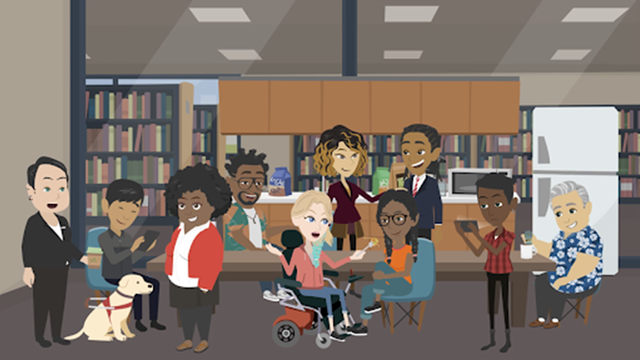Technology and Action & Expression
Technology can both enable and hinder access to action and expression. We explored some of these barriers in terms of the digital divide in Module 3. Many of the technologies we enjoy today are a result of disability innovation. For example, text-to-speech has allowed individuals with learning disabilities to record their ideas effectively. This same disability innovation has allowed smartphone users to easily send messages to friends while carrying groceries, or writers to record ideas while riding transit. However, technologies that increase accessibility and creativity for some may present barriers to others. For example, Augmented Reality (AR) and Virtual Reality (VR) may provide engaging learning environments for some learners, but may present barriers to others. Careful design considerations must be made by developers to ensure that learner variability is a consideration before requiring students to engage in AR/VR-enhanced spaces (Carleton University, n.d.). It’s important that we model the use of accessible technologies and encourage our learners to use technologies that are accessible to their peers. Luckily, there are various guidelines available to support this tool and technology selection process, including this rubric from the University of Western Ontario (UWO). In addition, your e-learning department can offer expertise in recommending technologies that serve your learners and learning goals, as well as audit any tool you are planning to use for AODA and Web Content Accessibility Guide (WCAG) 2.1 compliance. Remember the POUR principles introduced in the Multiple Means of Representation module that can be used to assess the digital accessibility of your learning materials and media? These principles can also be applied to any technologies you require students to use or produce in action and expression.
Offering Students Choice
Allowing students to choose the format and tool for their online assessment, when possible, helps to mitigate potential barriers – especially when the technical skills required are irrelevant constructs – while still attending to the course outcomes and assessment objectives. Online assessments may also require students (and educators) to develop new technical skills. Just like content-related knowledge and skills, these multimodal skills need to be learned and practiced before being assessed for grades. This doesn’t mean we shouldn’t try to optimize our use of technology to engage learners. It does mean we should carefully choose which technologies we use so that they:
- are accessible to our diverse learners, both in function and cost;
- facilitate learning outcomes (both for the course and learners’ own goals);
- foster technical skills development relevant to the field of study; and
- offer support and practice opportunities for both teachers and students learning how to use the new technology.
You can use these guidelines to choose how you might like to incorporate generative AI into your teaching practice. Let’s check in with our Educators Circle to see how they’re utilizing GenAI for action and expression in their learning spaces:
Educator circle activityAI and UDL Educator Circle
Complete this activity on the Universal Design for Learning website
Open activityInstructions
If using a mouse, trackpad, or touch device, click on the button over an educator in the group to open the educator slide. Use the next and previous buttons to navigate between educators and the close button to return to the group.
If using a keyboard or screen reader, press the tab key to focus on an educator in the group, and press space to open the educator slide. Once open you may use the Left arrow and Right arrow keys to navigate between educators. Press Escape to return to the group.

Transcript for Educator Circle
Using Technology That Aligns with Our Learning Outcomes
Dubec’s original concept has been adapted here (Word Count: 567) by a group of faculty for all three domains of Bloom’s Taxonomy.
Dr. Rhonda Dubec at Lakehead University constructed an informative graphic to help teachers decide what assessment options may fit with their cognitive learning outcomes in an online environment. In the original graphic, Dubec used multiple choice for summative assessments at every level of Bloom’s cognitive domain, but we have reduced its application.
Multiple choice is not always learner centred. Nevertheless, it is still widely used due to a variety of factors such as: managing workload, large class sizes, and preparing learners for licensing exams. Historically used by the U.S. Army to quickly sort troops into intelligence categories, multiple choice has since been adopted as an assessment method throughout higher education across the globe (Ramirez, 2013). Multiple choice can become more learner-centred by:
- engaging learners to co-create the questions
- utilizing multiple choice as a formative assessment
- encouraging students to utilize resources (such as readings and case studies) to answer higher-level (apply) multiple choice questions